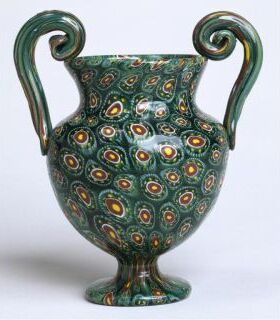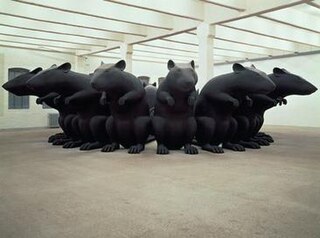
Dale Chihuly is an American glass artist and entrepreneur. He is perhaps best known in the field of blown glass, "moving it into the realm of large-scale sculpture".

Studio glass is the modern use of glass as an artistic medium to produce sculptures or three-dimensional artworks. The glass objects created are intended to make a sculptural or decorative statement. Though usage varies, the term is properly restricted to glass made as art in small workshops, typically with the personal involvement of the artist who designed the piece. This is in contrast to art glass, made by craftsmen in factories, and glass art, covering the whole range of glass with artistic interest made throughout history. Both art glass and studio glass originate in the 19th century, and the terms compare with studio pottery and art pottery, but in glass the term "studio glass" is mostly used for work made in the period beginning in the 1960s with a major revival in interest in artistic glassmaking.

Martin L. Puryear is an American artist known for his devotion to traditional craft. Working in wood and bronze, among other media, his reductive technique and meditative approach challenge the physical and poetic boundaries of his materials. The artist's Martin Puryear: Liberty/Libertà exhibition represented the United States at the 2019 Venice Biennale.

Millefiori is a glasswork technique which produces distinctive decorative patterns on glassware. The term millefiori is a combination of the Italian words "mille" (thousand) and "fiori" (flowers). Apsley Pellatt in his book Curiosities of Glass Making was the first to use the term "millefiori", which appeared in the Oxford English Dictionary in 1849; prior to that, the beads were called mosaic beads. While the use of this technique long precedes the term "millefiori", it is now most frequently associated with Venetian glassware.

Murrine are colored patterns or images made in a glass cane that are revealed when the cane is cut into thin cross-sections. Murrine can be made in infinite designs from simple circular or square patterns to complex detailed designs to even portraits of people. One familiar style is the flower or star shape which, when used together in large numbers from a number of different canes, is called millefiori.
Marvin Bentley Lipofsky was an American glass artist. He was one of the six students that Studio Glass founder Harvey Littleton instructed in a program at the University of Wisconsin-Madison in fall 1962 and spring 1963. He was a central figure in the dissemination of the American Studio Glass Movement, introducing it to California through his tenure as an instructor at the University of California, Berkeley and the California College of Arts and Crafts.

In glassblowing, cane refers to rods of glass with color; these rods can be simple, containing a single color, or they can be complex and contain strands of one or several colors in pattern. Caneworking refers to the process of making cane, and also to the use of pieces of cane, lengthwise, in the blowing process to add intricate, often spiral, patterns and stripes to vessels or other blown glass objects. Cane is also used to make murrine, thin discs cut from the cane in cross-section that are also added to blown or hot-worked objects. A particular form of murrine glasswork is millefiori, in which many murrine with a flower-like or star-shaped cross-section are included in a blown glass piece.
Wally Bill Hedrick was a seminal American artist in the 1950s California counterculture, gallerist, and educator who came to prominence in the early 1960s. Hedrick’s contributions to art include pioneering artworks in psychedelic light art, mechanical kinetic sculpture, junk/assemblage sculpture, Pop Art, and (California) Funk Art. Later in his life, he was a recognized forerunner in Happenings, Conceptual Art, Bad Painting, Neo-Expressionism, and image appropriation. Hedrick was also a key figure in the first important public manifestation of the Beat Generation when he helped to organize the Six Gallery Reading, and created the first artistic denunciation of American foreign policy in Vietnam. Wally Hedrick was known as an “idea artist” long before the label “conceptual art” entered the art world, and experimented with innovative use of language in art, at times resorting to puns.

Ron Nagle is an American sculptor, musician and songwriter. He is known for small-scale, refined sculptures of great detail and compelling color.

Richard "Dick" Marquis is an American studio glass artist. One of the first Americans ever to work in a Venetian glass factory, he became a master of Venetian cane and murrine techniques. He is considered a pioneer of American contemporary glass art, and is noted for his quirky, playful work that incorporates flawless technique and underlying seriousness about form and color.

Katharina Fritsch is a German sculptor. She lives and works in Düsseldorf, Germany.
Fletcher C. Benton was an American sculptor and painter from San Francisco, California. Benton was widely known for his kinetic art as well as his large-scale steel abstract geometric sculptures.
A glossary of terms used in glass art

Glass art refers to individual works of art that are substantially or wholly made of glass. It ranges in size from monumental works and installation pieces to wall hangings and windows, to works of art made in studios and factories, including glass jewelry and tableware.

Tom Joyce is a sculptor and MacArthur Fellow known for his work in forged steel and cast iron. Using skills and technology acquired through early training as a blacksmith, Joyce addresses the environmental, political, and social implications of using iron in his work. Exhibited internationally since the 1980s, his work is included in 30-plus public collections in the U.S. and abroad. Joyce works from studios in Santa Fe, New Mexico, and since 2012, in Brussels, Belgium, producing sculpture, drawings, prints, photographs, and videos that reference themes of iron in the human body, iron in industry, and iron in nature.

Robert Kehlmann is an artist and writer. He was an early spokesperson for evaluating glass art in the context of contemporary painting and sculpture. His glasswork has been exhibited worldwide and is the focus of numerous commentaries. Kehlmann's work can be found in museums and private collections in the United States, Europe and Asia. He has written books, articles, and exhibition reviews for publications in the U.S. and abroad. In 2014 the Rakow Research Library of The Corning Museum of Glass acquired Kehlmann's studio and research archives.

Joyce J. Scott is an African-American artist, sculptor, quilter, performance artist, installation artist, print-maker, lecturer and educator. Named a MacArthur Fellow in 2016, and a Smithsonian Visionary Artist in 2019, Scott is best known for her figurative sculptures and jewelry using free form, off-loom beadweaving techniques, similar to a peyote stitch. Each piece is often constructed using thousands of glass seed beads or pony beads, and sometimes other found objects or materials such as glass, quilting and leather. In 2018, she was hailed for working in new medium — a mixture of soil, clay, straw, and cement — for a sculpture meant to disintegrate and return to the earth. Scott is influenced by a variety of diverse cultures, including Native American and African traditions, Mexican, Czech, and Russian beadwork, illustration and comic books, and pop culture.
David Wiseman is an American artist and designer whose work is notable for its intricate craftsmanship and dialogue with traditional decorative arts. "Celebrated for groundbreaking sculpture, furniture, lighting and site-specific installations that combine natural forms with classical craftsmanship, David Wiseman is a creative tour de force." His work spans from bronze filagree patterned screens and gates to bronze and terrazzo furniture, from animal sculptures to porcelain vases.

David Huffman is an American painter and installation artist. He is known for works that combine science fiction aesthetics with a critical focus on the political exploration of identity.
Stan F. Dann was a contemporary Northern California artist known for his puzzle-like bas-relief wall sculptures of polychrome wood. His earlier commercial career during the 1960s-1970s produced popular carved wooden signage, graphics and art objects.




































